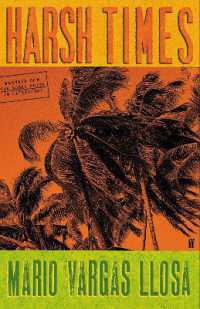- ホーム
- > 洋書
- > 英文書
- > Literary Criticism
基本説明
Coming from the flelds of literature, history, art history, and comparative literature, the fourteen contributors to this volume apply a range of methodologies to this new material and to other sources concerning women writers in China from 1600 to 1900.
Full Description
Until recently only a handful of women writers were thought to have existed in traditional China, but new scholarship has called attention to several hundred whose works have survived. Coming from the fields of literature, history, art history, and comparative literature, the fourteen contributors to this volume apply a range of methodologies to this new material and to other sources concerning women writers in China from 1600 to 1900.
An opening section on courtesans details the lives of individual women and their male admirers—contemporary and subsequent—who imposed an array of meaning on the category of woman writer. The works treated in this section are mainly poetry, although drama also enters in. The second section focuses on the writings of gentrywomen who, confined to the inner quarters of their residences, turned out a body of poetry impressive both for its volume and for the number of authors involved.
The third section takes up the issue of contextualization: how male writers situated women's poetry in their essays, stories, and travelogues. The fourth section pursues the same issue, but with reference to China's greatest work of fiction, Dream of the Red Chamber, first published in 1792, most of whose leading characters are talented gentrywomen. The volume concludes with a chapter by a specialist in comparative literature, who relates the concerns of the other chapters to literary and feminist studies outside the China field.
Contents
Contributors; Introduction Ellen Widmer; Part I. Writing the Courtesan: 1. Ambiguous images of courtesan culture in late imperial China Paul S. Ropp; 2. The late Ming courtesan: invention of a cultural ideal Wai-yee Li; 3. T he written word and the bound foot: a history of the courtesan's aura Dorothy Ko; 4. Desire and writing in the late Ming play Parrot Island Katherine Carlitz; 5. Women in Feng Menglong's Mountain Songs Yasushi Oki; Part II: Norms and Selves; 6. Ming and Qing anthologies of women's poetry and their selection strategies Kang-i Sun Chang; 7. Changing the subject: gender and self-inscription in authors' preafaces and Shi poetry Maureen Robertson; Part III. Poems in Context: 8. Writing her way out of trouble: Li Yuying in history and fiction Ann Waltner; 9. Embodying the disembodied: prepresentaions of ghosts and the feminine Judith T. Zeitlin; 10. De/constructing a feminine ideal in the eighteenth century: random records of West-Green and the story of Shuangqing Grace S. Fong; Part IV. 'Hong lou meng': 11. Womens writing before and within the Hong lou meng Huan Saussy; 12. Beyong stereotypes: the twelve beauties in Qing court art and the Dream of the Red Chamber Wu Hung; 13. Ming Loyalism and the women's voice in fiction after Hong lou meng Ellen Widmer; Postface: Chinese women in a comparative perspective: a response Nancy Armstrong; Reference matter; Notes; Works cited; Character list; Index.







